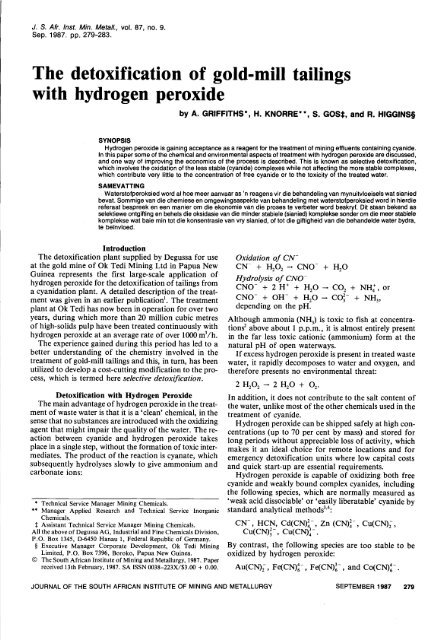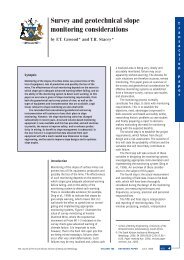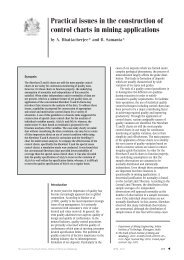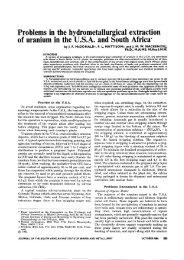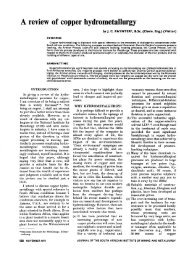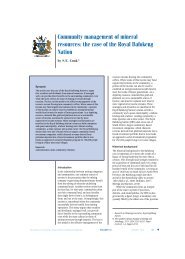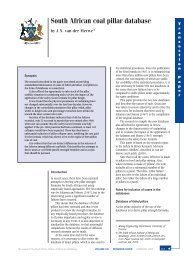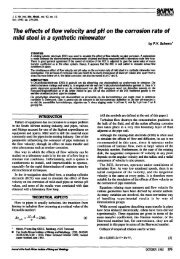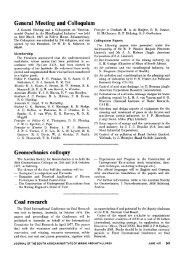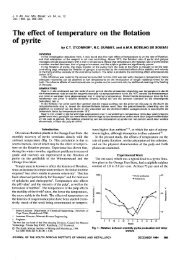The detoxification of gold-mill tailings with hydrogen peroxide - saimm
The detoxification of gold-mill tailings with hydrogen peroxide - saimm
The detoxification of gold-mill tailings with hydrogen peroxide - saimm
Create successful ePaper yourself
Turn your PDF publications into a flip-book with our unique Google optimized e-Paper software.
J. S. At,. Inst. Min. Metal/., vol. 87, no. 9.<br />
Sap. 1987. pp. 279-283.<br />
<strong>The</strong> <strong>detoxification</strong> <strong>of</strong> <strong>gold</strong>-<strong>mill</strong> <strong>tailings</strong><br />
<strong>with</strong> <strong>hydrogen</strong> <strong>peroxide</strong><br />
by A. GRIFFITHS., H. KNORRE**, S. GOS:I:,and R. HIGGINS§<br />
SYNOPSIS<br />
Hydrogen <strong>peroxide</strong> is gaining acceptance as a reagent for the treatment <strong>of</strong>.mining effluents c?ntaininQ cyanide.<br />
In this paper some <strong>of</strong> the chemical and environmental aspects <strong>of</strong> treatment <strong>with</strong> <strong>hydrogen</strong> <strong>peroxide</strong> are discussed,<br />
and one way <strong>of</strong> improving the economics <strong>of</strong> the process is described. This is known as selective <strong>detoxification</strong>,<br />
which involves the oxidation <strong>of</strong> the less stable (cyanide) complexes while not affecting the more stable complexes,<br />
which contribute very little to the concentration <strong>of</strong> free cyanide or to the toxicity <strong>of</strong> the treated water.<br />
SAMEVATTING<br />
Waterst<strong>of</strong>peroksied word al hoe meer aanvaar as 'n reagens vir die behandeling van mynuitvl?eisels w~t si~ni~d<br />
bevat. Sommige van die chemiese en omgewingsaspekte van behandeling met waterst<strong>of</strong>peroks,led word In hlerdle<br />
referaat bespreek en een manier om die ekonomie van die proses te verbeter word beskryf. Dlt s~aan bekend. as<br />
selektiewe ontgifting en behels die oksidasie van die minder stabiele (sianied) komplekse sonder om die meer stablele<br />
komplekse wat baie min tot die konsentrasie van vry sianied, <strong>of</strong> tot die giftigheid van die behandelde water bydra,<br />
te be"invloed.<br />
Introduction<br />
<strong>The</strong> <strong>detoxification</strong> plant supplied by Degussa for use<br />
at the <strong>gold</strong> mine <strong>of</strong> Ok Tedi Mining Ltd in Papua New<br />
Guinea represents the first large-scale application <strong>of</strong><br />
<strong>hydrogen</strong> <strong>peroxide</strong> for the <strong>detoxification</strong> <strong>of</strong> <strong>tailings</strong> from<br />
a cyanidation plant. A detailed description <strong>of</strong> the treatment<br />
was given in an earlier publication!. <strong>The</strong> treatment<br />
plant at Ok Tedi has now been in operation for over two<br />
years, during which more than 20 <strong>mill</strong>ion cubic metres<br />
<strong>of</strong> high-solids pulp have been treated continuously <strong>with</strong><br />
<strong>hydrogen</strong> <strong>peroxide</strong> at an average rate <strong>of</strong> over 1000 m3/h.<br />
<strong>The</strong> experience gained during this period has led to a<br />
better understanding <strong>of</strong> the chemistry involved in the<br />
treatment <strong>of</strong> <strong>gold</strong>-<strong>mill</strong> <strong>tailings</strong> and this, in turn, has been<br />
utilized to develop a cost-cutting modification to the process,<br />
which is termed here selective <strong>detoxification</strong>.<br />
Detoxification <strong>with</strong> Hydrogen Peroxide<br />
<strong>The</strong> main advantage <strong>of</strong> <strong>hydrogen</strong> <strong>peroxide</strong> in the treatment<br />
<strong>of</strong> waste water is that it is a 'clean' chemical, in the<br />
sense that no substances are introduced <strong>with</strong> the oxidizing<br />
agent that might impair the quality <strong>of</strong> the water. <strong>The</strong> reaction<br />
between cyanide and <strong>hydrogen</strong> <strong>peroxide</strong> takes<br />
place in a single step, <strong>with</strong>out the formation <strong>of</strong> toxic intermediates.<br />
<strong>The</strong> product <strong>of</strong> the reaction is cyanate, which<br />
subsequently hydrolyses slowly to give ammonium and<br />
carbonate ions:<br />
. Technical Service Manager Mining Chemicals.<br />
.. Manager Applied Research and Technical Service Inorganic<br />
Chemicals.<br />
:j: Assistant Technical Service Manager Mining Chemicals.<br />
All the above <strong>of</strong> Degussa AG, Industrial and Fine Chemicals Division,<br />
P.O. Box 1345, D-6450 Hanau 1, Federal Republic <strong>of</strong> Germany.<br />
§ Executive Manager Corporate Development, Ok Tedi Mining<br />
Limited, P.O. 'Box 7396, Boroko, Papua New Guinea.<br />
@ <strong>The</strong> South African Institute <strong>of</strong> Mining and Metallurgy, 1987. Paper<br />
received 13th February, 1987. SA ISSN 0038-223X/$3.00 + 0.00.<br />
Oxidation <strong>of</strong> CN-<br />
CN~ + HP2 - CNO- + H2O<br />
Hydrolysis <strong>of</strong> CNO-<br />
CNO- + 2 H+ + H2O CO2 + NH;, or<br />
CNO- + OH- + H2O - CO;- + NH3,<br />
depending on the pH.<br />
Although ammonia (NH3) is toxic to fish at concentration~<br />
above about 1 p. p.m., it is almost entirely present<br />
in the far less toxic cationic (ammonium) form at the<br />
natural pH <strong>of</strong> open waterways.<br />
If excess <strong>hydrogen</strong> <strong>peroxide</strong> is present in treated waste<br />
water, it rapidly decomposes to water and oxygen, and<br />
therefore presents no environmental threat:<br />
2 H202 - 2 H2O + °2'<br />
In addition, it does not contribute to the salt content <strong>of</strong><br />
the water, unlike most <strong>of</strong> the other chemicals used in the<br />
treatment <strong>of</strong> cyanide.<br />
Hydrogen <strong>peroxide</strong> can be shipped safely at high concentrations<br />
(up to 70 per cent by mass) and stored for<br />
long periods <strong>with</strong>out appreciable loss <strong>of</strong> activity, which<br />
makes it an ideal choice for remote locations and for<br />
emergency <strong>detoxification</strong> units where low capital costs<br />
and quick start-up are essential requirements.<br />
Hydrogen <strong>peroxide</strong> is capable <strong>of</strong> oxidizing both free<br />
cyanide and weakly bound complex cyanides, including<br />
the following species, which are normally measured as<br />
'weak acid dissociable' or 'easily liberatable' cyanide by<br />
standard analytical methods3.4:<br />
CN-, HCN, Cd(CN);-, Zn (CN);-, Cu(CN);,<br />
Cu(CN);-, Cu(CN)~-.<br />
By contrast, the following species are too stable to be<br />
oxidized by <strong>hydrogen</strong> <strong>peroxide</strong>:<br />
Au(CN);, Fe(CN):- , Fe(CN)~- , and Co(CN):- .<br />
JOURNAL OF THE SOUTH AFRICAN INSTITUTE OF MINING AND METALLURGY<br />
SEPTEMBER 1987 279
c:::::><br />
Fig. 1-Map showing the location<br />
<strong>of</strong> the Ok Tedi Mine<br />
,<br />
N<br />
"<br />
,<br />
0, 100 200 300<br />
Kilometers<br />
, ,<br />
00<br />
Ferrocyanide is not oxidized to ferricyanide by<br />
<strong>hydrogen</strong> <strong>peroxide</strong> in alkaline solution, thus permitting<br />
its subsequent removal by precipitation <strong>with</strong>, for example,<br />
copper ions:<br />
Fe(CN)t + 2 Cu2+- CU~I[Fell (CN)6]'<br />
Hydrogen <strong>peroxide</strong> was chosen on the basis <strong>of</strong> these<br />
advantages for the treatment <strong>of</strong> the <strong>tailings</strong> from the Ok<br />
Tedi Mine.<br />
per litre <strong>of</strong> <strong>tailings</strong> filtrate).<br />
Table I shows the typical composition <strong>of</strong> the <strong>tailings</strong><br />
before and after treatment <strong>with</strong> <strong>hydrogen</strong> <strong>peroxide</strong> during<br />
this initial period <strong>of</strong> operation <strong>of</strong> the <strong>detoxification</strong> plant.<br />
After about eight months <strong>of</strong> operation, during which<br />
the consumption <strong>of</strong> <strong>hydrogen</strong> <strong>peroxide</strong> was close to the<br />
design figure, a progressive change in the composition<br />
<strong>The</strong> Ok Tedi Mine<br />
<strong>The</strong> Ok Tedi Mine is situated near the centre <strong>of</strong> the<br />
island <strong>of</strong> New Guinea, in an area <strong>of</strong> extremely high rainfall<br />
(Fig. 1). About 22,5 kt <strong>of</strong> ore are treated daily <strong>with</strong><br />
sodium cyanide in the carbon-in-pulp process, giving rise<br />
to a <strong>tailings</strong> flow <strong>of</strong> about 1400 m3/h at 45 per cent<br />
solids. After treatment <strong>with</strong> <strong>hydrogen</strong> <strong>peroxide</strong> and<br />
cycloning, the slime fraction is discharged to the Ok Mani<br />
river (Fig. 2). About 15 km further downstream, the Ok<br />
Mani joins the Ok Tedi, where further dilution takes<br />
place.<br />
<strong>The</strong> concentrations <strong>of</strong> cyanide that have to be met by<br />
Ok Tedi Mining Ltd were originally 3,5 p.p.b. <strong>of</strong> free<br />
cyanide (24 h average) and 52 p. p. b. maximum. <strong>The</strong> point<br />
<strong>of</strong> measurement was chosen to be Ningerum, which lies<br />
some 60 km downstream <strong>of</strong> the Ok Mani-Ok Tedi confluence,<br />
because <strong>of</strong> the importance <strong>of</strong> fish as a food<br />
source for the local inhabitants <strong>of</strong> Ningerum and the surrounding<br />
area. <strong>The</strong>se criteria were changed at the beginning<br />
<strong>of</strong> 1986 to 30 p.p.b. <strong>of</strong> free cyanide (24 h average)<br />
and 70 p.p.b. (peak).<br />
At the time Ok Tedi went into production, there was<br />
no method for the analysis <strong>of</strong> such a low concentration<br />
<strong>of</strong> free cyanide. Thus, in order to ensure that the limit<br />
would not be exceeded due to the formation <strong>of</strong> free<br />
cyanide by the dissociation <strong>of</strong> weakly complexed cyanide<br />
on dilution in the Ok Tedi river, the Company decided<br />
that the concentration <strong>of</strong> easily liberatable cyanide should<br />
be reduced by treatment <strong>with</strong> <strong>hydrogen</strong> <strong>peroxide</strong> to less<br />
than 1 p.p.m. (which is equivalent to 1 mg <strong>of</strong> free cyanide<br />
0<br />
>- 0<br />
--,<br />
c<br />
0<br />
'-<br />
!<br />
N<br />
10 , 20,<br />
"<br />
Kilometers<br />
Fig. 2-Map showing the Ok Tedi river system<br />
30,<br />
280 SEPTEMBER 1987 JOURNAL OF THE SOUTH AFRICAN INSTITUTE OF MINING AND METALLURGY
TABLE I<br />
EFFECT OF TREATMENT WITH HYDROGEN PEROXIDE<br />
Before treat- After treatment<br />
<strong>with</strong> ment <strong>with</strong><br />
Parameter H202 H202<br />
Flow <strong>of</strong> <strong>tailings</strong>, mJ/h 1100 1100<br />
Solids, % 45 45<br />
pH. 10,5 to 11,0 10,2 to 10,8<br />
CNt, mgll 50 to lOO Undetected<br />
Easily-lib. CNt, mgll 90 to 200 < 0,5<br />
Total cyanide§, mgll 110 to 300 I to 10<br />
Dissolved metals", mgl!<br />
Cu 50 to lOO < 0,5<br />
Zn 10 to 30 < 0,1<br />
Fe I to 3 I to 3<br />
. A slight reduction in pH (0,2 to 0,3) takes place during the <strong>detoxification</strong><br />
reaction<br />
t Argentometric, 10 ml sample, 0,01 N AgNOJ solution, rhodanine<br />
indicator<br />
~ Colorimetric determination <strong>with</strong> test kit from E. Merck, based on<br />
the pyridine-barbituric acid methods5<br />
§ Distillation <strong>of</strong> HCN according to the German DIN standard<br />
method4<br />
Metals determined<br />
**<br />
by atomic-absorption spectroscopy<br />
<strong>of</strong> the <strong>mill</strong> feed took place, which led to an increase in<br />
the consumption <strong>of</strong> cyanide and a corresponding increase<br />
in the consumption <strong>of</strong> <strong>hydrogen</strong> <strong>peroxide</strong>.<br />
<strong>The</strong> reason for the increased consumption was traced<br />
to the presence <strong>of</strong> unexpectedly large amounts <strong>of</strong> cyanidesoluble<br />
copper minerals, which occurred in certain parts<br />
<strong>of</strong> the orebody. This problem was subsequently mitigated<br />
by selective mining, but it was evident that high levels<br />
<strong>of</strong> dissolved copper resulted in a high consumption <strong>of</strong><br />
oxidizing agent, and ways were sought to combat this.<br />
One possible answer was selective <strong>detoxification</strong>, by<br />
which is meant the oxidation <strong>of</strong> the less stable (cyanide)<br />
complexes while leaving the more stable complexes, which<br />
contribute very little to the concentration <strong>of</strong> free cyanide<br />
or to the toxicity <strong>of</strong> the treated water.<br />
Selective Detoxification<br />
<strong>The</strong> concept <strong>of</strong> selective <strong>detoxification</strong> <strong>of</strong> cyanide complexes<br />
is not entirely new, since complex iron cyanides<br />
are normally left untouched by oxidative treatment <strong>with</strong><br />
<strong>hydrogen</strong> <strong>peroxide</strong> or chlorine. In this case, however, the<br />
intention was to control the addition <strong>of</strong> <strong>hydrogen</strong> <strong>peroxide</strong><br />
in such a way as to leave not only the ferrocyanide<br />
but also some <strong>of</strong> the copper complex Cu(CN); unoxidized.<br />
In order to be able to evaluate the results <strong>of</strong> selective<br />
<strong>detoxification</strong>, it was necessary to develop a method for<br />
the measurement <strong>of</strong> free cyanide in river water down to<br />
5 p.p.b. and below. This was undertaken by Ok Tedi<br />
Mining Ltd. Degussa undertook the investigation <strong>of</strong> the<br />
theoretical background to permit the prediction <strong>of</strong> free<br />
cyanide levels on the basis <strong>of</strong> measurements <strong>of</strong> total<br />
cyanide and total copper.<br />
<strong>The</strong>oretical Background<br />
<strong>The</strong> important cyanide species present in Ok Tedi <strong>tailings</strong><br />
are the following:<br />
Fe(CN)t, Zn(CN);-, Cu(CN)~-, Cu(CN);-,<br />
Cu(CN);, HCN, and CN- .<br />
Of these, the ferrocyanide remains untouched by the<br />
<strong>detoxification</strong> reaction, although some may be removed<br />
from the river water by precipitation <strong>with</strong> divalent metal<br />
cations.<br />
<strong>The</strong> formation <strong>of</strong> free cyanide by photolytic decomposition<br />
<strong>of</strong> any remaining ferrocyanide ions was not expected<br />
to be a major problem in Ok Tedi's case, because<br />
the river water is too turbid to allow much penetration<br />
<strong>of</strong> sunlight and the concentrations <strong>of</strong> dissolved iron are<br />
very small (typically 3 to 5 p.p.m. in the <strong>tailings</strong> filtrate).<br />
Complex zinc cyanide is attacked quickly by <strong>hydrogen</strong><br />
<strong>peroxide</strong> owing to the weakne'ss Of the cornprex,'a:nd is<br />
detoxified as rapidly as the free cyanide.<br />
A large proportion <strong>of</strong> the cyanide in solution in untreated<br />
<strong>tailings</strong> is bound to copper. <strong>The</strong>se copper complexes<br />
must be considered in more detail in order to explain<br />
the concept <strong>of</strong> selective <strong>detoxification</strong> more clearly.<br />
Three cyanocuprate complexes are known, which exist<br />
in equilibrium <strong>with</strong> each other and <strong>with</strong> CN-:<br />
Cu(CN)~- - Cu(CN);- + CNpK4<br />
= 2,15<br />
Cu(CN);- - Cu(CN); + CNpK3<br />
= 4,5<br />
Cu(CN);<br />
- Cu+ + 2 CN-<br />
(32 = 21.<br />
<strong>The</strong> values <strong>of</strong> the dissociation constants quoted6 above<br />
are higher than some others that have appeared in the<br />
literature. <strong>The</strong>se higher values were chosen for use in the<br />
calculations in order to provide an extra safety margin.<br />
One further equation must be considered, which describes<br />
the pH-dependent equilibrium between HCN and<br />
CN-:<br />
HCN + OH- - CN- + HzO<br />
pK = 9,36.<br />
<strong>The</strong> value <strong>of</strong> the dissociation constant is that given by<br />
Broderius7.<br />
A computer program was developed by Degussa, which<br />
uses these equations to predict equilibrium concentrations<br />
<strong>of</strong> CN- , HCN, and the three complexes for given total<br />
concentrations <strong>of</strong> cyanide and copper, and for given pH<br />
values. A typical result is shown in Fig. 3, in which the<br />
distribution <strong>of</strong> cyanide among the various forms is shown<br />
for a total copper concentration <strong>of</strong> to-3 moVI and a pH<br />
<strong>of</strong> 10.<br />
At a CN/Cu mole ratio (called Q in Fig. 3) <strong>of</strong>2 : 1 (and<br />
below), the cyanide in solution is present entirely as<br />
Cu(CN); at the concentrations and pH values shown in<br />
Fig. 3. This is due to the extremely low dissociation constant<br />
for this complex (10-Z1). As the CN concentration<br />
rises (the total copper concentration is considered to be<br />
constant in this example at to-3 moVI), the proportion<br />
<strong>of</strong> cyanide in the Cu(CN); form drops quickly, while<br />
the proportion present as Cu(CN);- rises, and reaches a<br />
maximum at a CN/Cu ratio <strong>of</strong> about 3: 1. <strong>The</strong> Cu(CN)~complex<br />
increases steadily in importance through the<br />
CN/Cu range shown (2 to 5), as does the proportion <strong>of</strong><br />
free cyanide, both as CN- and as HCN.<br />
<strong>The</strong> line at Q - 5 in Fig. 3 indicates a situation that<br />
JOURNAL OF THE SOUTH AFRICAN INSTITUTE OF MINING AND METALLURGY SEPTEMBER 1987 281
Total Copper ~ ImMol/l (63.5ppm)<br />
pH-Value<br />
~<br />
10<br />
1 0<br />
QJ 0.9<br />
D<br />
.r<<br />
c 0.8<br />
ro<br />
>- 0.7<br />
u<br />
0.6<br />
'
daily flow levels), thus enabling a wider range <strong>of</strong> analytical<br />
methods to be used.<br />
Results<br />
Selective <strong>detoxification</strong> has been practised at Ok Tedi<br />
for over a year <strong>with</strong> encouraging results. <strong>The</strong> measured<br />
concentrations <strong>of</strong> free cyanide in the Ok Tedi at Ningerum<br />
are consistently below the predicted levels, as expected<br />
from the losses <strong>of</strong> free cyanide via natural degradation<br />
during the 12-hour transit time between the Ok Mani<br />
and Ningerum. Fig. 4 demonstrates the extent to which<br />
selective <strong>detoxification</strong> has assisted the operations <strong>of</strong> 0 k<br />
Tedi Mining Ltd. In spite <strong>of</strong> a marked trend <strong>of</strong> increasingcopper<br />
concentrations in the pulp being treated, the<br />
concentrations <strong>of</strong> free cyanide in the river at Ningerum<br />
have been maintained at acceptable levels <strong>with</strong>out incurring<br />
high reagent consumptions. As the analytical and<br />
process-control procedures have become more finely<br />
tuned, the consumption <strong>of</strong> <strong>hydrogen</strong> <strong>peroxide</strong> has even<br />
been reduced. <strong>The</strong> curve shows a period <strong>of</strong> increased<br />
<strong>hydrogen</strong> <strong>peroxide</strong> consumption around January 1986,<br />
~ 200<br />
c<br />
0<br />
"0<br />
~ 100<br />
QJ<br />
u<br />
C<br />
0<br />
U<br />
0<br />
Cyanide soluble copper before <strong>detoxification</strong><br />
40 Free cyanide at Ningerum<br />
:::-<br />
Cl<br />
.3- 20<br />
z<br />
u<br />
0<br />
c<br />
B 2.0<br />
a. Relative H202 cx>nsumption (28th July 1985 1.0) =<br />
E<br />
:::>


